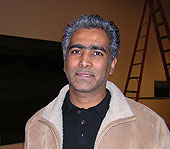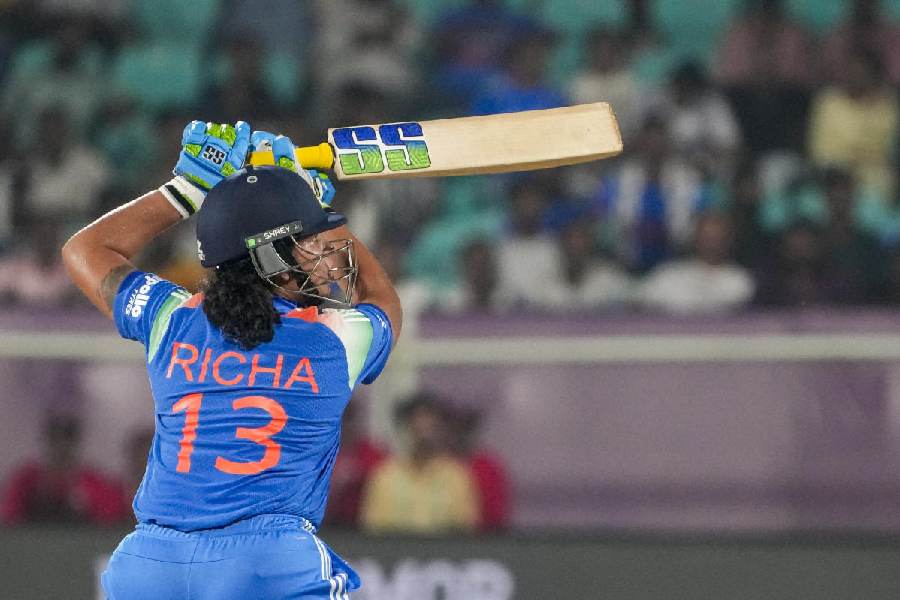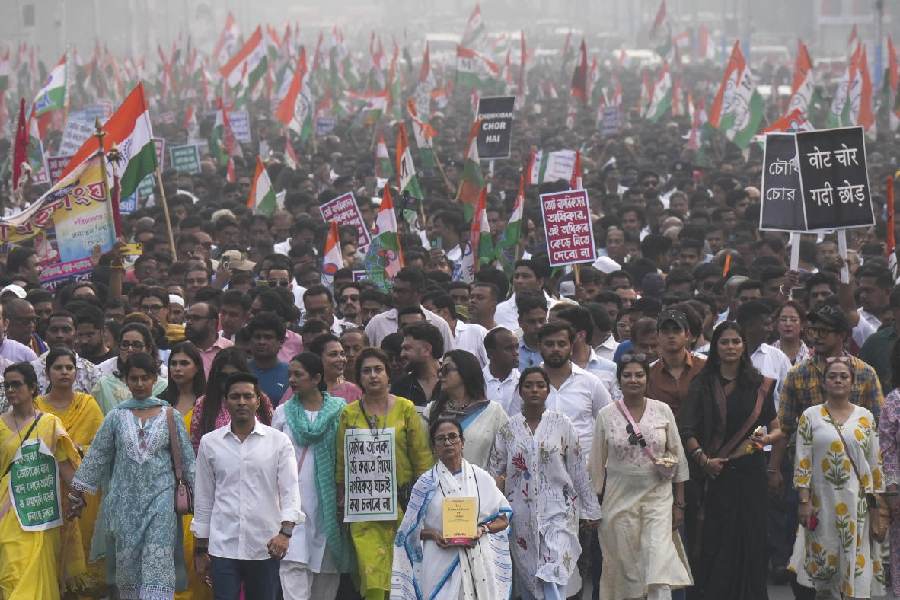|
|
| BRIDGING THE GAP: Sundaram Tagore |
Sundaram Tagore, an increasingly influential figure in the art world, nods when I ask whether he is striving to evolve a sort of “Santiniketan in New York”. In opening the Sundaram Tagore Gallery in the Soho area of New York, he feels he is fulfilling his mission in life — “How do we continue the le-gacy?”
The legacy is, of course, that of Rabindranath Tagore and the ideals behind Santiniketan. “Tagore was my great-grand-uncle and my father’s grand-uncle,” explains Sundaram. Although New York has been Sundaram’s “mental” home since he hit the city in 1980, he has lived all over the place — Delhi, Mussoorie, Ohio in California, Canada, Italy and Oxford. At heart, though, he has not stopped being a Calcutta boy.
“Calcutta (as a cultural and business centre) at one point was perhaps more important than Singapore, Hong Kong, Bangkok or even Tokyo. Why were we not able to change?” he asks. “Because people started relying too much on the past.” Sundaram is determined his gallery, set up to encourage East-West understanding, should not charge for cultural events held in its premises. His ambition, he stresses, is “to create dialogue and give voice to people who do not have a voice. We did things on Afghanistan when it wasn’t even an issue. The gallery is about creating a bridge between cultures and bringing people together.”
Sundaram assures me that the Indian art scene in America is “very vibrant and there are some remarkable people in it”. But he also points out that “a lot of galleries or shows in museums only cater to NRIs.” He wants to move Indian art into the mainstream.
“It’s a struggle,” he admits. “Anything worthwhile is not easy.” He acknowledges that in recent weeks, there has been blanket coverage of the Indian cultural scene in the US media and worries this might backfire. “What is happening is over-saturation,” he observes. “I call it the pashmina effect.” By this he means one moment everybody wants a pashmina, the next, the shawl is out of fashion. “With over-saturation people might retrack as it becomes too common,” he argues.
Sundaram, who is currently setting up a website linked to his gallery, loyally awarded the contract to an IT firm in America. “I was very unhappy with it,” he discloses. “I had the website for a year and a half but could not release it to the public. It wouldn’t function, you could not navigate it, people got stuck. Now, I have given the same amount of money to someone in India and they are doing a fantastic job.”
He dismisses the pledge by John Kerry, the Democratic presidential hope, to end outsourcing to India as election waffle.
|
|
| FAITH AND POWER: Narmeen Husain |
Another key Calcutta-born figure in New York’s bustling arts scene is Narmeen Husain, who for the past eight years has been publicity manager of the Metropolitan Museum of Art, the world’s biggest museum after the Louvre.
On a rainy afternoon, Narmeen whizzes me round the museum where her job is to promote its many products — everything from replica sculptures to scarves, stationery, special books, publications, posters, postcards, prints and, of course, jewellery.
For four years she had previously worked as a banker with Chase Manhattan but could not wait to leave. Now, she loves each day. “Oh, it’s not a job, it’s a hobby, it’s so much fun,” she laughs.
The museum is breathtakingly grand but a heart-warming sight is to see little children curled on the marble floor sketching great art works.
Narmeen’s late mother, Faizunnisa (“Rosie”) Yusuf Jamal Ahad — “she dragged me through the museums of the world from the age of two” — was the daughter of a Calcutta doctor, while her father, Mohamed Husain, was from Comilla in East Bengal.
They met at Calcutta University. Narmeen’s mother then went to the universities of Minnesota and Columbia to do a PhD on Edith Sitwell, the English poet, but returned home when her baby was due. “I was born in Eden Hospital,” says Narmeen.
I am rushed through the museum’s current big exhibition, ‘Byzantium: Faith and Power (1261-1557)’, where Narmeen is, again, responsible for promoting the associated merchandise.
Here, too, there is outsourcing for India, for all the jewellery has been at made to the museum’s specifications by the Kasliwals of Jaipur at their local Gem Palace.
“Jewellery is a big seller for the museum,” confirms Narmeen. At the Met, the entrance fee is a “suggested” $12, which means people, if they so wish, can get in for nothing. Narmeen herself has understood the importance of art in her personal life.
Her apartment, which is 15 minutes’ walk away, has “a few paintings from Pakistan, a couple of paintings from Bangladesh, a sketch by a Dutch artist, called Delhi Gate, which I picked up from Christie’s. It’s a mish-mash but I can’t think of being in a space without art.”
In America, corporate sponsorship of the arts, she says, “is an established thing”. In fact, the Metropolitan Museum was funded by rich merchants, who qualified, in the absence of a European-style landed aristocracy, as “the royalty of America”.
We walk through many wings in the museum named after their benefactors.
Meanwhile, Narmeen urges Indian businessmen, too, to seriously consider sponsoring the arts. She urges them “to think more altruistically in terms of what their vision is.”
“It’s not just money but something way beyond money. Eventually, sponsorship will carry their names into the future for many generations to come.”
|
|
 |
| BANNERS Galore: An anti-Bush slogan in New York (top); Bombay Dreams at the Broadway Theatre |
The number of Indian tourists heading abroad is expected to jump to six million this year, up 30 per cent in 2003, and over the next five years, outbound Indian tourism will increase by 15 per cent year, according to an article (“Indian Travel is set for Takeoff”) in The Wall Street Journal. All this is attributed to economic liberalisation and the growth of the Indian middle classes.
As I walked from the Broadway Theatre, where Bombay Dreams is certain to prove a huge desi draw, along 53rd Street, to do a spot of window-shopping on Fifth Avenue, I was never very far from the sound of Indian voices.
There are certainly things to do and see in New York — example a provocative, red banner in Union Square, proclaiming, “The Bush Regime Engineered 9-11.”
Sadly, America’s most famous symbol remains out of bounds. The Statue of Liberty, which has been the only monument to remain closed since 9-11, will reopen in July after work to make the pedestal secure for visitors. But the crown will stay out of bounds because it represents “an attractive terrorist target”.
Just as well that the Americans aren’t big on irony.
Who should pop his head out of the lift at the Radisson Lexington but Anupam Kher? He brushes aside my suggestion he should go and see Bombay Dreams. Instead, he recommends something involving his wife, Kiron.
They will live a long time, I tell them. Only minutes earlier, I had clipped out a page from the New York Times, which had favourably reviewed Silent Waters, an entry in the New Directors/ New Films series, starring Kiron Kher as the mother of a pleasant young Pakistani man who is corrupted by Islamic fundamentalism. “She was in the lift,” motions her proud husband.
My New York cousin, a heavy smoker, took me to one of only three New York bars where puffing cigarettes has not been outlawed.
More than 200 young men and women sat in a darkened space, united by the collective worship of smoking. The walls were covered with a variety of cigarette ads.
To me, a non-smoker but reasonably tolerant (I like to think) towards smokers, this was a vision of hell. But I have never seen a happier lot. My late father, who was addicted to the Charminar brand, would have approved.
We still have in our Calcutta home his ash tray, shaped like a skull, inscribed with the words, “It is better to smoke here than hereafter.”













